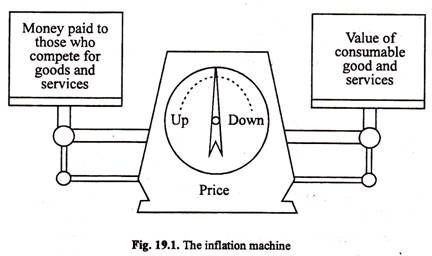The below mentioned article provides an overview on the value of money and the price level.
Subject Matter:
The average level of all prices in a country is called the price level. There are thousands of waves in a sea, each wave having a different height.
Nevertheless, we can calculate the average level of the sea and call it the sea- level. Similarly, we can calculate the price level, although there are thousands of prices, all moving in different ways.
When the price level rises money can buy less goods and services. So we say that its purchasing power has fallen. Conversely, when the price level falls, money can buy more and we can say its purchasing power has gone up. Thus, the value of money changes inversely with the price level. In our country, the price level increased by about 400% during World War n (1939-1945). The value of the rupee fell by the same percentage.
Why Does the Price Level Change?
Changes in the price level are caused by two factors:
ADVERTISEMENTS:
(a) changes in the supply of money, and
(b) changes in the supply of goods and services.
When the quantity of money in circulation in a country is increased (e.g., by printing new notes) more money is available to the people for making purchases, the demand for goods and services goes up and the price level tends to rise.
ADVERTISEMENTS:
Conversely, if the supply of money decreases people can buy less and the price level tends to go down. Again, if there is an increase in the supply of goods and services, the price level tends to fall and, in the converse case, it tends to rise.
Thus, if the supply of money increases by 25% and the supply of goods and services also increases by the same 25%, there will ordinarily be no effect on the price level. There are other factors which influence the price level (e.g., the number of times money changes hands or the velocity of circulation) but the first two factors are the most important of all.
In India, during World War II, there was a large increase in the volume of notes printed by the Government. There was, at the same time, a decrease in the supply of goods (due to reduction of imports, etc.). Consequently, the price level increased many times.
It is possible to analyse the causes of price changes in a different way. Modern writers believe that price level changes are brought about by changes in the level of income, i.e., the average amount of money earned by that people when more income is earned, the demand for the goods and services goes up and price rise. When income falls, less goods and services are demanded and price fall. [Changes in the level of income depend on two factors, the volume of savings and the volume of investment in the country.]
The Inflation Machine:
When inflation is reduced to its simplest elements, its proximate causes can easily be identified. Figure 19.1 represents the inflation machine. Let us assume for a moment that the value of the consumable goods and services produced is in balance with the money paid to all those who compete for the purchase of the goods and services.
ADVERTISEMENTS:
Then prices will remain unchanged. Of course, prices of individual items will fluctuate due to changes in demand and supply conditions, but the aggregate price level will be stable. In fact, the inflation machine is nothing more than or less than a broad view of supply and demand and the market clearing price.
Now, if we load the left hand side of the inflation machine with more money than the value of goods and services on the right side, prices will surely increase. Competition for the limited amount of goods that is available will rare prices. Another way to load the left hand side of the inflation machine is for the same number of rupees to be spent with greater frequency. This is called increasing the velocity of money.
The rupees flow through the economic system faster and this creates a similar effect. Alternatively, if people take money out of savings and spend it, that increases the number of rupees in competition for the available goods. The effect is the same—competition for what is available on the right side will drive prices up.
